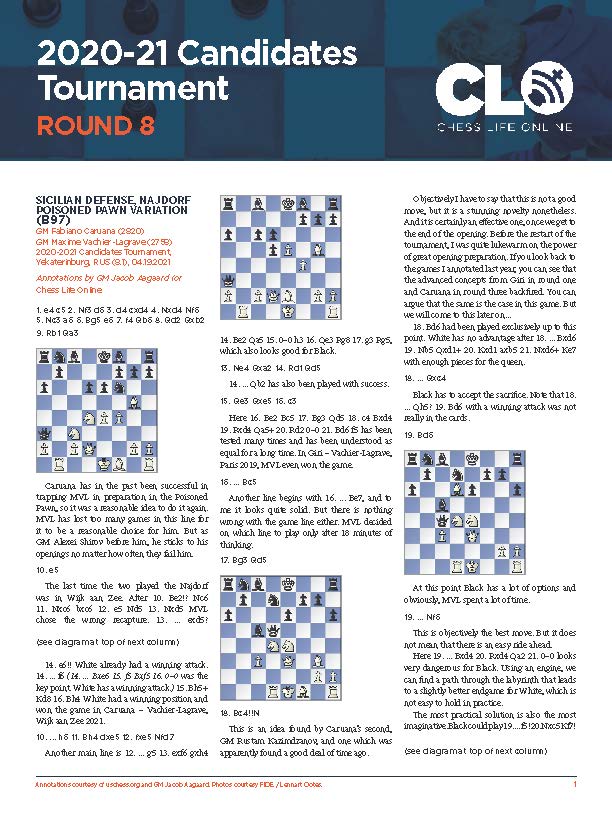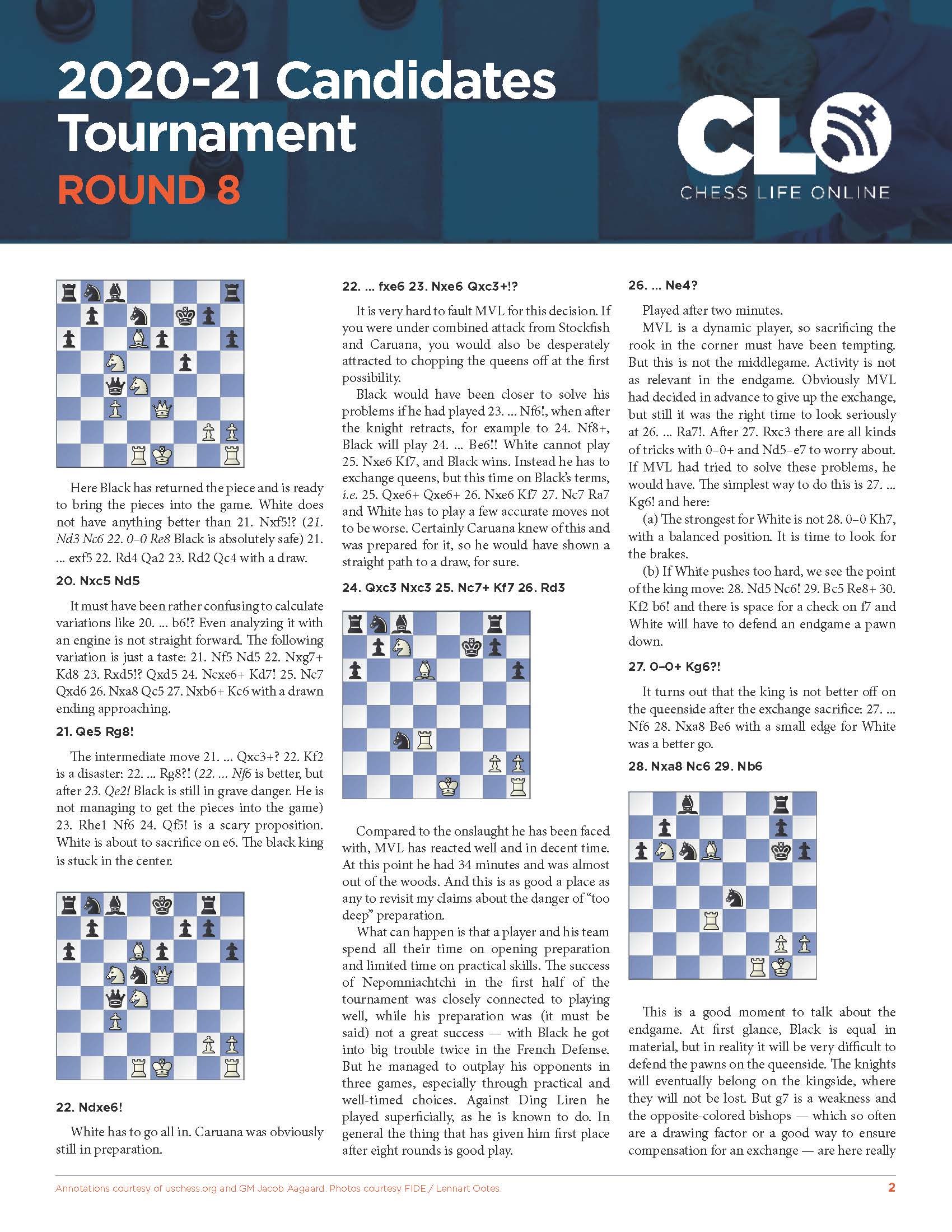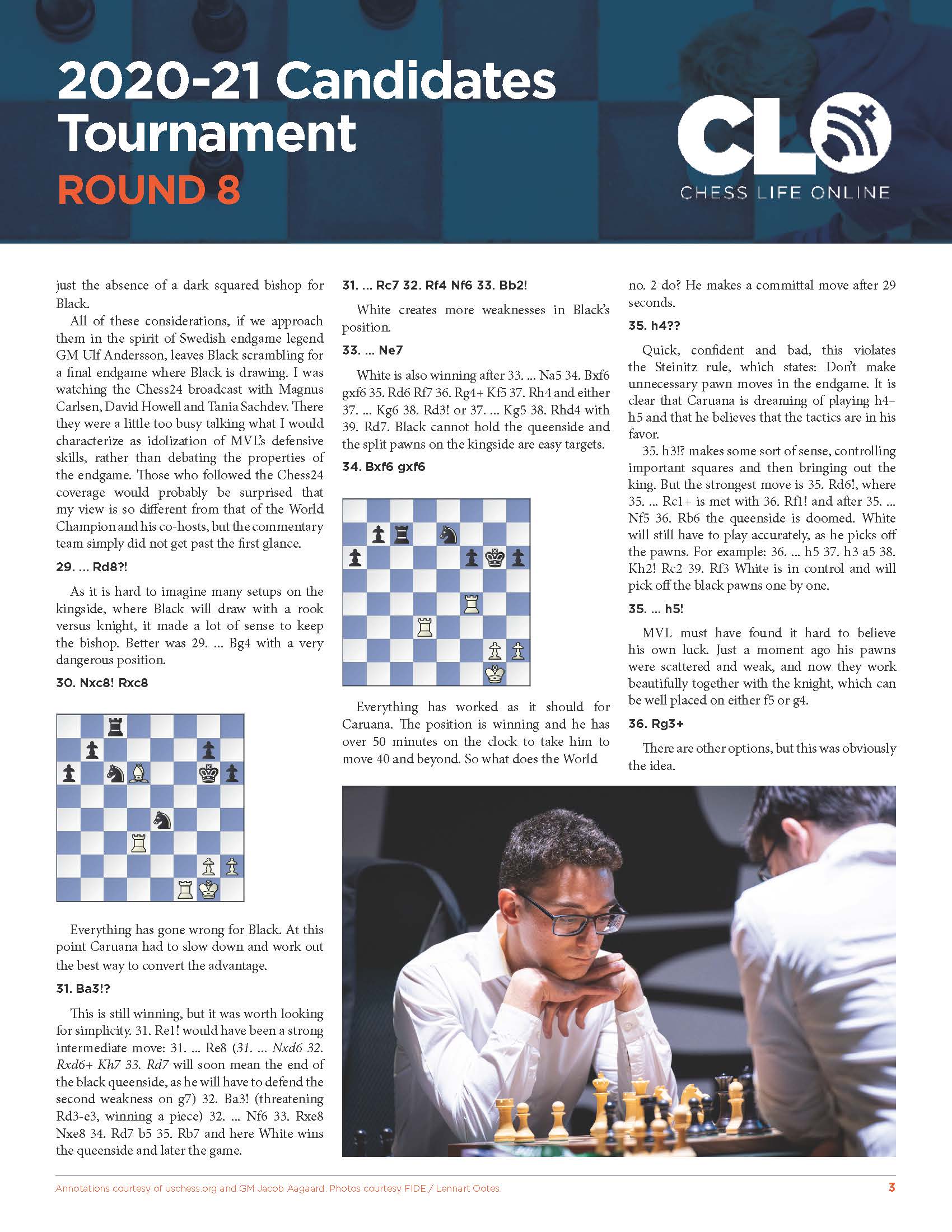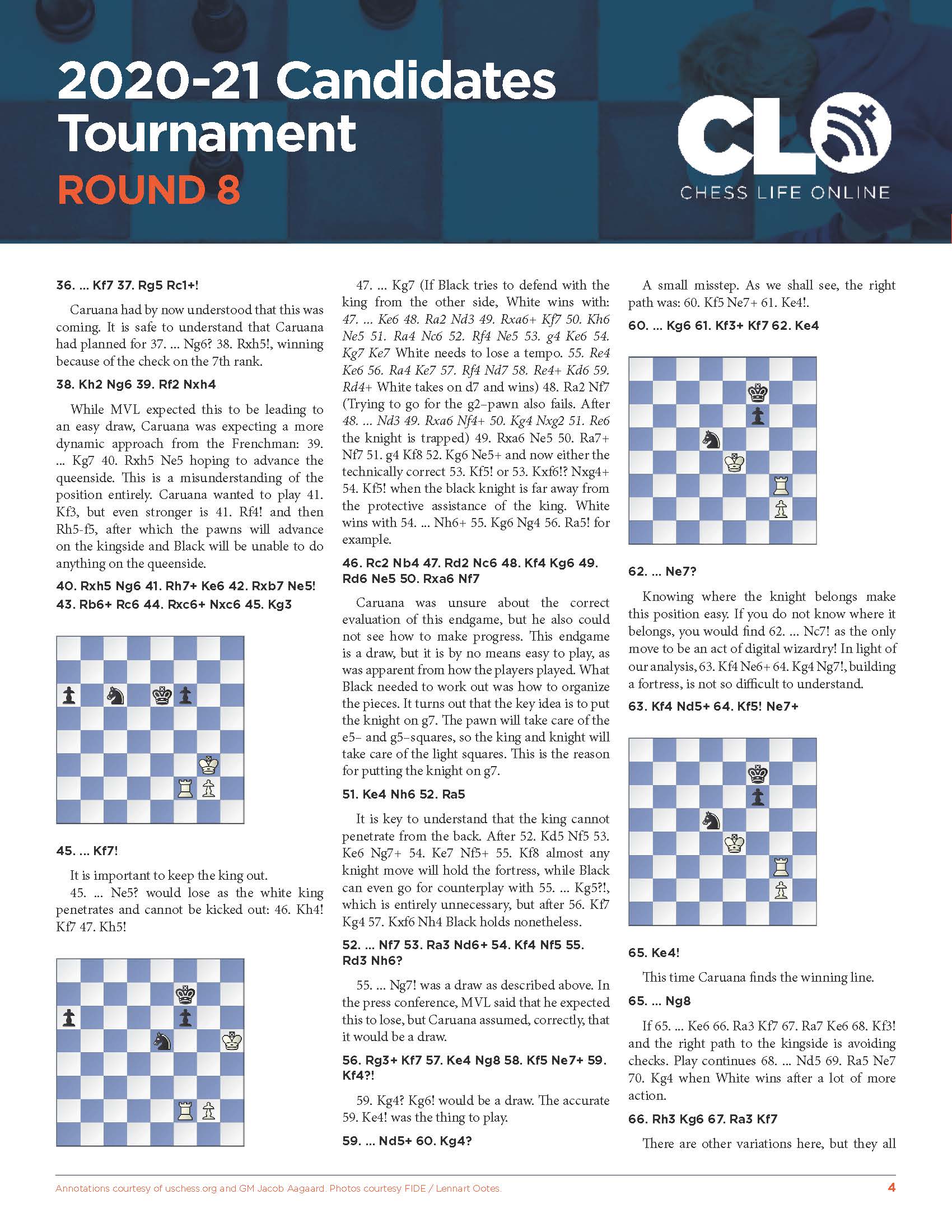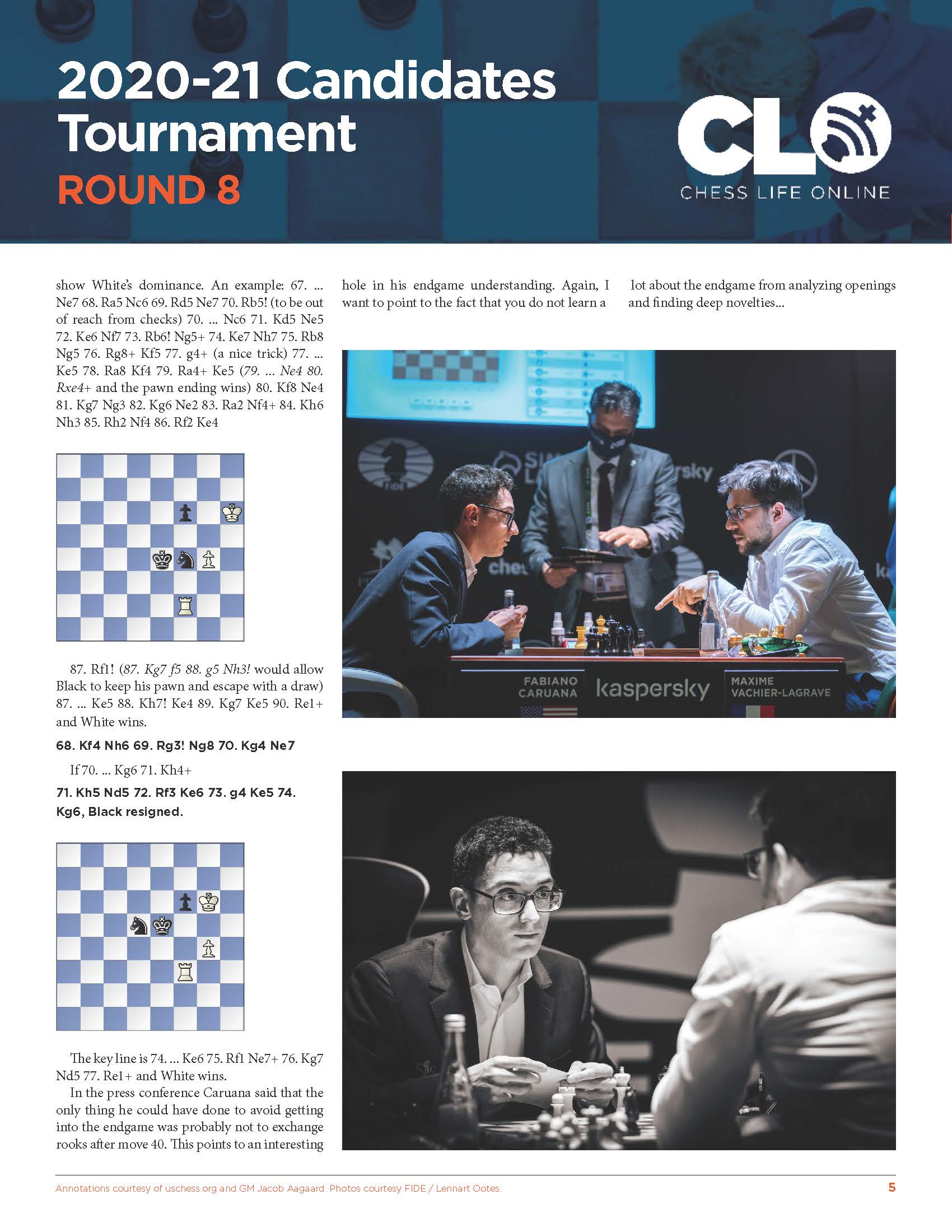For the eight installment of his “Candidates Game of the Day” series, GM Jacob Aagaard has analyzed GM Fabiano Caruana's smashing victory over GM Maxime Vachier-Lagrave as only he could – deeply, extensively, definitively. This is the analysis that the experts will be quoting tomorrow, and we have it exclusively here at Chess Life Online.
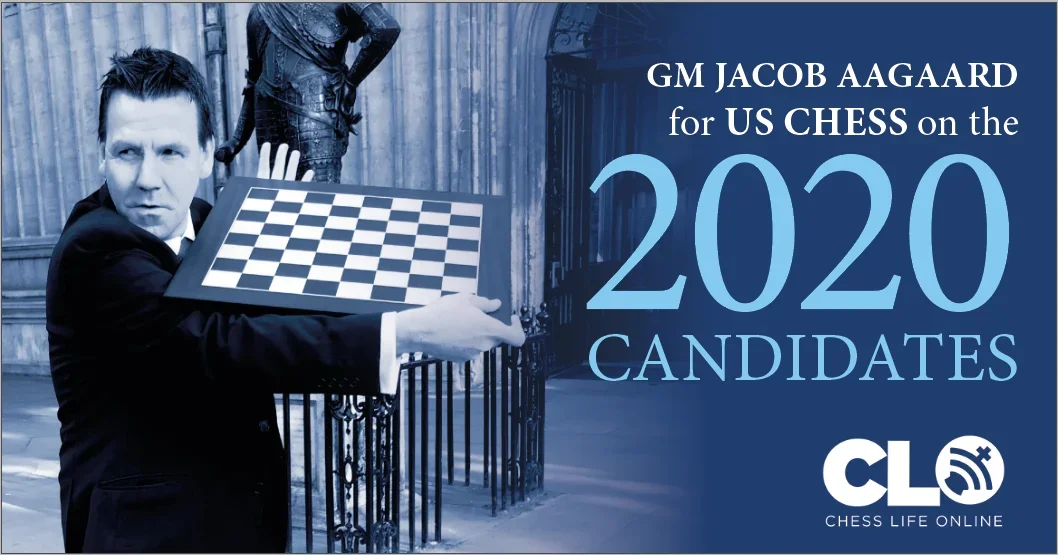
Fans of Aagaard's work may also want to check out his recap of Round 8 on the Killer Chess Training YouTube channel.
https://youtu.be/DzWN6x1ccTE
Below we provide Aagaard’s analysis in replayable format. For those who prefer paper, boards, and pieces, we have created a pdf version.
You can also check out an alternative replayable version posted in the ChessBase Cloud.
[pgn][Event "FIDE Candidates Tournament"] [Site "chess24.com"] [Date "2021.04.19"] [Round "8.1"] [White "Caruana, Fabiano"] [Black "Vachier-Lagrave, Maxime"] [Result "1-0"] [ECO "B97"] [WhiteElo "2820"] [BlackElo "2758"] [Annotator "GM Jacob Aagaard"] [PlyCount "147"] [EventDate "2021.??.??"] [WhiteTeam "United States"] [BlackTeam "France"] [WhiteTeamCountry "USA"] [BlackTeamCountry "FRA"] 1. e4 c5 2. Nf3 d6 3. d4 cxd4 4. Nxd4 Nf6 5. Nc3 a6 6. Bg5 e6 7. f4 Qb6 8. Qd2 Qxb2 9. Rb1 Qa3 {[#] Caruana has in the past been successful in trapping MVL in preparation in the Poisoned Pawn, so it was a reasonable idea to do it again. MVL has lost too many games in this line for it to be a reasonable choice for him. But as Alexei Shirov before him, he sticks to his openings no matter how often they fail him.} 10. e5 ({The last time the two played the Najdorf was in Wijk Aan Zee. After} 10. Be2 $5 Nc6 11. Nxc6 bxc6 12. e5 Nd5 13. Nxd5 {MVL chose the wrong recapture.} exd5 $2 {[#]} 14. e6 $3 {White already had a winning attack.} f6 (14... Bxe6 15. f5 Bxf5 16. O-O {was the key point. White has a winning attack.}) 15. Bh5+ Kd8 16. Bh4 {White had a winning position and won the game in Caruana – Vachier Lagrave, Wijk aan Zee 2021.}) 10... h6 11. Bh4 dxe5 12. fxe5 Nfd7 (12... g5 13. exf6 gxh4 14. Be2 Qa5 15. O-O h3 16. Qe3 Rg8 17. g3 Rg5 {is another main line, which also looks good for Black.}) 13. Ne4 Qxa2 14. Rd1 Qd5 (14... Qb2 {has also been played with success.}) 15. Qe3 Qxe5 16. c3 (16. Be2 Bc5 17. Bg3 Qd5 18. c4 Bxd4 19. Rxd4 Qa5+ 20. Rd2 O-O 21. Bd6 f5 {has been tested many times and has been understood as equal for a long time. In Giri – Vachier Lagrave, Paris 2019, MVL even won the game.}) 16... Bc5 (16... Be7 {is another line. To me it looks quite solid. But there is nothing wrong with the game line either. MVL decided on which line to play only after 18 minutes of thinking.}) 17. Bg3 Qd5 {[#]} 18. Bc4 $3 $146 {This is an idea found by Rustam Kazimdzanov, which was found a good deal of time ago. Objectively not a good move, but a stunning novelty none the less. And certainly an effective one, once we get to the end of the opening. Before the restart of the tournament, I was quite lukewarm on the power of great opening preparation. If you look back to the games I annotated last year, you can see that the advanced concepts from Giri in round 1 and Caruana in round 3 backfired. You can argue that the same is the case in this game. But we will come to this later on...} (18. Bd6 {has been played exclusively up to this point. White has no advantage after:} Bxd6 19. Nb5 Qxd1+ 20. Kxd1 axb5 21. Nxd6+ Ke7 {, with enough pieces for the queen.}) 18... Qxc4 { Black has to accept the sacrifice.} (18... Qh5 $2 19. Bd6 {with a winning attack was not really in the cards.}) 19. Bd6 {[#] At this point Black has a lot of options and obviously, MVL spent a lot of time.} Nf6 {This is objectively the best move. But it does not mean that there is an easy ride ahead.} (19... Bxd4 20. Rxd4 Qa2 21. O-O {looks very dangerous for Black. Using an engine, we can find a path through the labyright that leads to a slightly better endgame for White, which is not easy to hold in practice.}) ({ The most practical solution is also the most imaginative. Black could play} 19... f5 $1 20. Nxc5 Kf7 $3 {[#] Black has returned the piece and is ready to bring the pieces into the game. White does not have anything better than} 21. Nxf5 $5 (21. Nd3 Nc6 22. O-O Re8 {Black is absolutely safe.}) 21... exf5 22. Rd4 Qa2 23. Rd2 Qc4 {with a draw.}) 20. Nxc5 Nd5 ({It must have been rather confusing to calculate variations like} 20... b6 $5 {Even analysing it with an engine is not straight forward. The following variation is just a taste.} 21. Nf5 Nd5 22. Nxg7+ Kd8 23. Rxd5 $5 Qxd5 24. Ncxe6+ Kd7 $1 25. Nc7 Qxd6 26. Nxa8 Qc5 27. Nxb6+ Kc6 {with a drawn ending approaching.}) 21. Qe5 Rg8 $1 ({The intermediate move} 21... Qxc3+ $2 22. Kf2 {is a disaster.} Rg8 $6 (22... Nf6 { is better, but after} 23. Qe2 $1 {Black is still in grave danger. He is not managing to get the pieces into the game.}) 23. Rhe1 Nf6 24. Qf5 $1 {is a scary proposition. White is about to sacrifice on e6. The black king is stuck in the centre.}) 22. Ndxe6 $1 {White has to go all in. Caruana was obviously still in preparation.} fxe6 23. Nxe6 {[#]} Qxc3+ $5 {It is very hard to fault MVL for this decision. If you were under combined attack from Stockfish and Caruana, you would also be desperately attracted to chopping the queens off at the first possibility.} ({Black would have been closer to solve his problems if he had played} 23... Nf6 $1 {, when after the knight retracts, for example to} 24. Nf8+ {, Black will play} Be6 $3 {White cannot play 25.Nxe6 Kf7, and Black wins. So instead he has to exchange queens, but this time on Black's terms.} 25. Qxe6+ Qxe6+ 26. Nxe6 Kf7 27. Nc7 Ra7 {and White has to play a few accurate moves not to be worse. Certainly Caruana knew of this and was prepared for it, so he would have shown a straight path to a draw, for sure.}) 24. Qxc3 Nxc3 25. Nc7+ Kf7 26. Rd3 {[#] Compared to the onslaught he has been faced with, MVL has reacted well and in decent time. At this point he had 34 minutes and is almost out of the woods. And this is the time where I would like to revisit my claim about the danger of too deep preparation. What can happen is that a player and his team spend all their time on opening preparation and limited time on practical skills. The success of Nepomnichtchi in the first half of the tournament was closely connected to playing well; while his preparation was not a great success. With Black he got into big trouble twice in the French Defence. But he managed to outplay his opponents in three games, especially through practical and well-timed choices. Against Ding Liren he played superficially, as he is known to do. But in general the thing that has given him a first after eight rounds, is good play.} Ne4 $2 { Played after two minutes.} ({MVL is a dynamic player, so sacrificing the rook in the corner must have been tempting. But this is not the middlegame. Activity is not as relevant in the endgame. Obviously MVL had decided in advance to give up the exchange, but still it was the right time to look seriously at} 26... Ra7 $1 {After} 27. Rxc3 {there are all kinds of tricks with 0-0+ and Nd5-e7 to worry about. If MVL had tried to solve these problems, he would have. The simplest way to do this is:} Kg6 $1 {The strongest for White is not 28.0-0 Kh7, with a balanced position. It is time to look for the brakes. If White pushes too hard, we see the point of the king move:} 28. Nd5 Nc6 $1 29. Bc5 Re8+ 30. Kf2 b6 $1 {and there is space for a check on f7 and White will have to defend an endgame a pawn down.}) 27. O-O+ Kg6 $6 ({It turns out that the king is not better off on the queenside after the exchange sacrifice.} 27... Nf6 28. Nxa8 Be6 {with a small edge for White was a better go.}) 28. Nxa8 Nc6 29. Nb6 {[#] This is a good moment to talk about the endgame. At first glance, Black is equal in material. But in reality it will be very difficult to defend the pawns on the queenside. The knights will eventually belong on the kingside, where they will not be lost. But g7 is a weakness and the opposite coloured bishops, which so often are a drawing factor, or a good way to ensure compensation for an exchange, are here really just the absence of a dark squared bishop for Black. All of these considerations, if we approach them in the spirit of Swedish endgame legend Ulf Andersson, leaves Black scrambling for a final endgame where Black is drawing. It does not take too long to conclude that it may be with two pawns each on the kingside I was watching the Chess24 broadcast with Magnus Carlsen, David Howell and Tania Sachdev. And there they were a little too busy talking what I would characterise as idolisation of MVL's defensive skills, rather than debating the properties of the endgame. Those who followed it, would probably be surprised that my view is so different from that of the World Champion and his co-hosts, but they simply did not get past the first glance.} Rd8 $6 ({As it is hard to imagine many setups on the kingside, where Black will draw with a rook vs. knight, it made a lot of sense to keep the bishop.} 29... Bg4 {with a very dangerous position was thus better.}) 30. Nxc8 $1 Rxc8 { [#] Everything has gone wrong for Black. At this point Caruana had to slow down and work out the best way to convert the advantage.} 31. Ba3 $5 {This is still winning, but it was worth looking for simplicity.} (31. Re1 $1 {would have been a strong intermediate move.} Re8 (31... Nxd6 32. Rxd6+ Kh7 33. Rd7 { will soon mean the end of the black queenside, as he will have to defend the second weakness on g7.}) 32. Ba3 $1 {Threatening Rde3, winning a piece.} Nf6 33. Rxe8 Nxe8 34. Rd7 b5 35. Rb7 {White wins the queenside and later the game.} ) 31... Rc7 32. Rf4 Nf6 33. Bb2 $1 {White creates more weaknesses in Black's position.} Ne7 ({White is also winning after} 33... Na5 34. Bxf6 gxf6 35. Rd6 Rf7 36. Rg4+ Kf5 37. Rh4 {and either 37...Kg6 38.Rd3! or} Kg5 38. Rhd4 { with 39.Rd7. Black cannot hold the queenside and the split pawns on the kingside are easy targets.}) 34. Bxf6 gxf6 {[#] Everything has worked as it should for Caruana. The position is winning and has over 50 minutes on the clock to take him to move 40 and beyond. So what does the World no. 2 do? He makes a committal move after 29 seconds.} 35. h4 $4 {Quick, confident and bad. Violating the Steinitz rule, stating: Don't make unnecessary pawn moves in the endgame. It is clear that Caruana is dreaming of playing h4-h5 and that he believes that the tactics are in his favour.} (35. h3 $5 {makes some sort of sense, controlling important squares and then bringing out the king.}) ({ But the strongest move is} 35. Rd6 $1 {, where 35...Rc1+ is met with 36.Rf1! and after} Nf5 36. Rb6 {the queenside is doomed. White will still have to play accurately, as he pikc off the pawns. For example:} h5 37. h3 a5 38. Kh2 $1 Rc2 39. Rf3 {White is in control and will pick off the black pawns one by one.}) 35... h5 $1 {MVL must have found it hard to believe his own luck. A moment before his pawns were scattered and weak, now they work beautifully together with the knight, which can be well placed on either f5 or g4.} 36. Rg3+ { There are other options, but this was obviously the idea.} Kf7 37. Rg5 Rc1+ $1 {Caruana had by now understood that this was coming. It is safe to understand that Caruana had planned for} (37... Ng6 $2 38. Rxh5 $1 {, winning because of the check on the 7th rank.}) 38. Kh2 Ng6 39. Rf2 Nxh4 {While MVL expected this to be leading to an easy draw, Caruana was expecting a more dynamic approach from the Frenchman:} (39... Kg7 40. Rxh5 Ne5 {hoping to advance the queenside. This is a misunderstanding of the position entirely. Caruana wanted to play 41. Kf3, but even stronger is} 41. Rf4 $1 {and Rhf5, after which the pawns will advance on the kingside and Black will be unable to do anything on the queenside.}) 40. Rxh5 Ng6 41. Rh7+ Ke6 42. Rxb7 Ne5 $1 43. Rb6+ Rc6 44. Rxc6+ Nxc6 45. Kg3 {[#]} Kf7 $1 {It is important to keep the king out.} (45... Ne5 $2 {would lose as the white king penetrates and cannot be kicked out:} 46. Kh4 $1 Kf7 47. Kh5 $1 {[#]} Kg7 ({If Black tries to defend with the king from the other side, White wins with:} 47... Ke6 48. Ra2 Nd3 49. Rxa6+ Kf7 50. Kh6 Ne5 51. Ra4 Nc6 52. Rf4 Ne5 53. g4 Ke6 54. Kg7 Ke7 {White needs to lose a tempo.} 55. Re4 Ke6 56. Ra4 Ke7 57. Rf4 Nd7 58. Re4+ Kd6 59. Rd4+ {White takes on d7 and wins.}) 48. Ra2 Nf7 ({Trying to go for the g2-pawn also fails. After} 48... Nd3 49. Rxa6 Nf4+ 50. Kg4 Nxg2 51. Re6 {the knight is trapped.}) 49. Rxa6 Ne5 50. Ra7+ Nf7 51. g4 Kf8 52. Kg6 Ne5+ {and now either the technically correct 53.Kf5! or} 53. Kxf6 $5 Nxg4+ 54. Kf5 $1 {The black knight is far away from the protective assistance of the king. White wins.} Nh6+ 55. Kg6 Ng4 56. Ra5 $1 {for example.}) 46. Rc2 Nb4 47. Rd2 Nc6 48. Kf4 Kg6 49. Rd6 Ne5 50. Rxa6 Nf7 { Caruana was unsure about the correct evaluation of this endgame, but could also not see how to make progress. This endgame is a draw, but it is by no means easy to play, as was apparent from how the players played. What Black needed to work out was how to organise the pieces. It turns out that the key idea is to put the knight on g7. The pawn will take care of the e5- and g5-squares, so the king and knight will take care of the light squares. Thus the knight on g7.} 51. Ke4 Nh6 52. Ra5 ({It is key to understand that the king cannot penetrate from the back. After} 52. Kd5 Nf5 53. Ke6 Ng7+ 54. Ke7 Nf5+ 55. Kf8 {almost any knight move will hold the fortress, while Black can even go for counterplay with} Kg5 $6 {, which is entirely unnecessary, but after} 56. Kf7 Kg4 57. Kxf6 Nh4 {Black holds none the less.}) 52... Nf7 53. Ra3 Nd6+ 54. Kf4 Nf5 55. Rd3 Nh6 $2 (55... Ng7 $1 {[%csl Ge6,Gf5,Gh5] was a draw as described. In the press conference, MVL said that he expected for this to lose, but Caruana assumed, correctly, that it would be a draw.}) 56. Rg3+ Kf7 57. Ke4 Ng8 58. Kf5 Ne7+ {[#]} 59. Kf4 $6 (59. Kg4 $2 Kg6 $1 {would be a draw.}) ({ But the accurate} 59. Ke4 $1 {was the thing to play.}) 59... Nd5+ 60. Kg4 $2 ({ A small misstep. As we shall see, the right path was:} 60. Kf5 Ne7+ 61. Ke4 $1 {.}) 60... Kg6 61. Kf3+ Kf7 62. Ke4 {[#]} Ne7 $2 ({Knowing where the knight belongs make this position easy. If you do not know where it belongs, you would find} 62... Nc7 $1 {as the only move to be an act of digital wizardry. But actually,} 63. Kf4 Ne6+ 64. Kg4 Ng7 $1 {with a fortress, is not so difficult to understand.}) 63. Kf4 Nd5+ 64. Kf5 $1 Ne7+ {[#]} 65. Ke4 $1 { This time Caruana finds the winning line.} Ng8 (65... Ke6 66. Ra3 Kf7 67. Ra7 Ke6 68. Kf3 $1 {The right path to the kingside is avoiding checks.} Nd5 69. Ra5 Ne7 70. Kg4 {White wins after a lot of more action.}) 66. Rh3 Kg6 67. Ra3 Kf7 ( {There are other variations here. They all show White's dominance.} 67... Ne7 68. Ra5 Nc6 69. Rd5 Ne7 70. Rb5 $1 {To be out of reach from checks.} Nc6 71. Kd5 Ne5 72. Ke6 Nf7 73. Rb6 $1 Ng5+ 74. Ke7 Nh7 75. Rb8 Ng5 76. Rg8+ Kf5 77. g4+ {A nice trick.} Ke5 78. Ra8 Kf4 79. Ra4+ Ke5 (79... Ne4 80. Rxe4+ {and the pawn ending wins.}) 80. Kf8 Ne4 81. Kg7 Ng3 82. Kg6 Ne2 83. Ra2 Nf4+ 84. Kh6 Nh3 85. Rh2 Nf4 86. Rf2 Ke4 {[#]} 87. Rf1 $1 (87. Kg7 f5 88. g5 Nh3 $1 { would allow Black to keep his pawn and escape with a draw.}) 87... Ke5 88. Kh7 $1 Ke4 89. Kg7 Ke5 90. Re1+ {White wins.}) 68. Kf4 Nh6 69. Rg3 $1 Ng8 70. Kg4 Ne7 (70... Kg6 71. Kh4+) 71. Kh5 Nd5 72. Rf3 Ke6 73. g4 Ke5 74. Kg6 (74. Kg6 { Black resigned.} Ke6 75. Rf1 Ne7+ 76. Kg7 Nd5 77. Re1+ {and White wins. In the press conference Caruana said that the only thing he could have done to avoid getting into the endgame was probably not to exchange rooks after move 40. This points to an interesting hole in his endgame understanding. It just shows that even the best players in the World have holes in their play. Again, I want to point to the fact that you do not learn a lot about the endgame from analysing openings and finding deep novelties...}) 1-0 [/pgn]
Previous "Aagaard on the Candidates" installments:
Round 1 - Giri-Nepomniachtchi
Round 2 - Caruana-Alekseenko
Round 3 - Ding Liren-Caruana
Round 4 - Vachier-Lagrave - Grischuk
Round 5 - Nepomniachtchi - Wang Hao
Round 6 - Nepomniachtchi - Ding Liren
Round 7 - Vachier-Lagrave - Nepomniatchtchi
Categories
Archives
- December 2025 (25)
- November 2025 (29)
- October 2025 (39)
- September 2025 (27)
- August 2025 (29)
- July 2025 (43)
- June 2025 (25)
- May 2025 (24)
- April 2025 (29)
- March 2025 (29)
- February 2025 (20)
- January 2025 (24)
- December 2024 (34)
- November 2024 (18)
- October 2024 (35)
- September 2024 (23)
- August 2024 (27)
- July 2024 (44)
- June 2024 (27)
- May 2024 (31)
- April 2024 (51)
- March 2024 (34)
- February 2024 (25)
- January 2024 (26)
- December 2023 (29)
- November 2023 (26)
- October 2023 (37)
- September 2023 (27)
- August 2023 (37)
- July 2023 (47)
- June 2023 (33)
- May 2023 (37)
- April 2023 (45)
- March 2023 (37)
- February 2023 (28)
- January 2023 (31)
- December 2022 (23)
- November 2022 (32)
- October 2022 (31)
- September 2022 (19)
- August 2022 (39)
- July 2022 (32)
- June 2022 (35)
- May 2022 (21)
- April 2022 (31)
- March 2022 (33)
- February 2022 (21)
- January 2022 (27)
- December 2021 (36)
- November 2021 (34)
- October 2021 (25)
- September 2021 (25)
- August 2021 (41)
- July 2021 (36)
- June 2021 (29)
- May 2021 (29)
- April 2021 (31)
- March 2021 (33)
- February 2021 (28)
- January 2021 (29)
- December 2020 (38)
- November 2020 (40)
- October 2020 (41)
- September 2020 (35)
- August 2020 (38)
- July 2020 (36)
- June 2020 (46)
- May 2020 (42)
- April 2020 (37)
- March 2020 (60)
- February 2020 (38)
- January 2020 (45)
- December 2019 (34)
- November 2019 (35)
- October 2019 (42)
- September 2019 (45)
- August 2019 (56)
- July 2019 (44)
- June 2019 (35)
- May 2019 (40)
- April 2019 (48)
- March 2019 (61)
- February 2019 (39)
- January 2019 (30)
- December 2018 (29)
- November 2018 (51)
- October 2018 (45)
- September 2018 (29)
- August 2018 (49)
- July 2018 (35)
- June 2018 (31)
- May 2018 (39)
- April 2018 (31)
- March 2018 (26)
- February 2018 (33)
- January 2018 (30)
- December 2017 (26)
- November 2017 (24)
- October 2017 (30)
- September 2017 (30)
- August 2017 (31)
- July 2017 (28)
- June 2017 (32)
- May 2017 (26)
- April 2017 (37)
- March 2017 (28)
- February 2017 (30)
- January 2017 (27)
- December 2016 (29)
- November 2016 (24)
- October 2016 (32)
- September 2016 (31)
- August 2016 (27)
- July 2016 (24)
- June 2016 (26)
- May 2016 (19)
- April 2016 (30)
- March 2016 (36)
- February 2016 (28)
- January 2016 (32)
- December 2015 (26)
- November 2015 (23)
- October 2015 (16)
- September 2015 (28)
- August 2015 (28)
- July 2015 (6)
- June 2015 (1)
- May 2015 (2)
- April 2015 (1)
- February 2015 (3)
- January 2015 (1)
- December 2014 (1)
- July 2010 (1)
- October 1991 (1)
- August 1989 (1)
- January 1988 (1)
- December 1983 (1)


